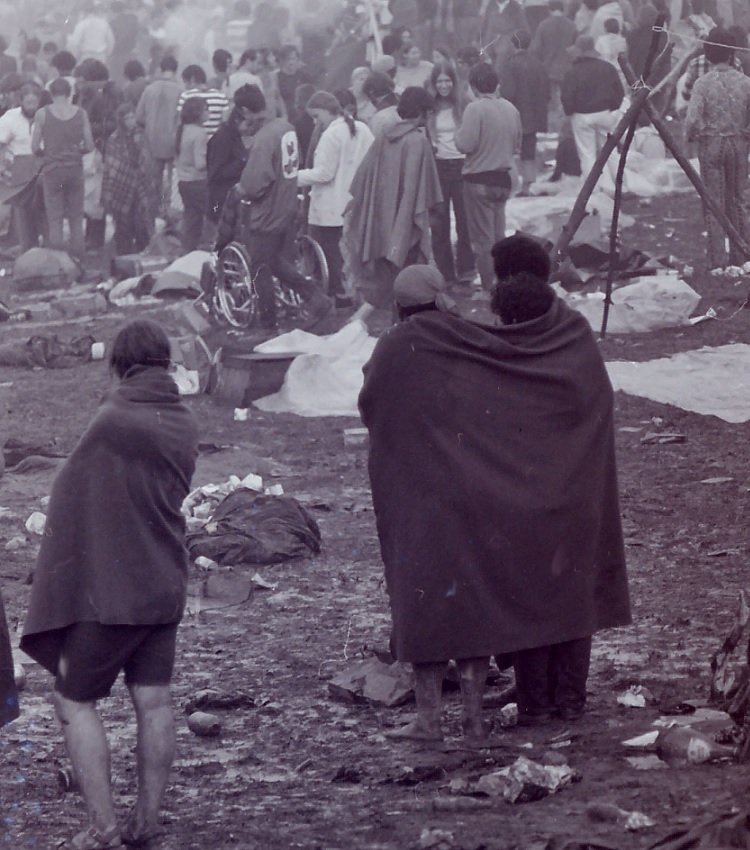Back to the Garden | Reflecting on Woodstock at 50
How many of this summer’s music festivals will be remembered? Probably none. Woodstock, August 1969, however, has its historic place in culture (or counterculture) assured; an ‘Aquarian Exposition of Peace and Music’ as the poster’s dove proclaimed from its lofty perch on blue guitar; a retort to the victory of the moon landing the previous month. Of the two happenings, it was clear which was the more crucial to the inheritors of the Earth.
Fifty thousand were expected to attend but they arrived with their half a million new best friends. On and on they came on blistered feet – a moving pointillistic Seurat painting of beads, embroidery, flowers, blue jeans and flowing hair. Hippies, bikers, rockers rollers, runaways, artists and students all converged on Max Yasgur’s dairy farm outside the village of Bethel, New York, on August 15th, 1969 for the Woodstock Music and Arts festival – a four-day festival that would symbolize the optimism and energy of the 60’s counterculture. It would be the creative flowering of love and peace on the perennial bindweed of protests and war-on-everything.
Thirty-two of the most celebrated acts of the day performed: a (guitar) string of bands – Canned Heat, The Grateful Dead, The Who, mixed with legendary artists Melanie, Joan Baez, Janis Joplin. Adorned in psychedelic tie-dye, Joe Cocker’s electrifying performance whipped up an actual tempest. Rain and lightning shot from the sky as his gravelly, growling of the Beatles With a Little Help from My Friends …. called up a rousing refrain from the crowd and the refrain was heartfelt. Jan Hodenfield put it best in his definitive account for Rolling Stone Magazine. ‘The earth dissolved into slime,’ he wrote, but ‘the crowd burst into a joyous community…in the dawning of the Aquarian Age everyone was in the same puddle.’
Despite the shortages, the hunger and thirst, it was the weekend when free-love, rock-n- roll and cheap drugs were the answer to all life’s problems. The most stimulating intoxicant, however, was not the cheap mescaline or acid, but the camaraderie of the crowd, its collective mind a balm of chemicals – mellowed, affable, lenient and stoic. It changed a chaotic mud-fest into an epic display of peace and love. Overt political activity was discouraged. Some, however, employed covert means.

On the morning of August 18th Jimi Hendrix appeared on stage, dressed in the colours of the American flag, and brought the festival to a crashing, two-hour finish. Following a medley of Purple Haze, Voodoo Child and Foxy Lady he began his fabled deconstruction of the Star-Spangled Banner – a rendition that, at the time, appalled many but delighted most; a rendition that is now regarded as a State of the Union address. His Stratocaster’s macabre mixture of rumbles and wails ventriloquising the evocative cries of tinderbox ghettos, Manson murder victims and the savagery of the Vietnam War. Painstakingly drawing out distortion- drenched chords, he held a note here, pressured the tremolo there, sending the pitch downward to groan like a moan of distress; then upwards to the screech of artillery fire, automatic weapons and the long, shrill, shriek of air raids. Like a shot, heard around the world, he discharged a first-hand delivery of the ugliness behind the glory that the anthem is supposed to represent. His guitar’s frenzied lament an artistic statement equalling Picasso’s ‘Charnel House’ or ‘Guernica.’
https://www.youtube.com/watch?v=MwIymq0iTsw
And then Jimi Hendrix left the stage and the festival and the 60s were over. The rock critic for the New York Post believed that he had witnessed the ‘single greatest moment’ of the decade.
The New York Times did not agree; on that day, August 18th its editorial thundered on about such an ‘outrageous episode.’ But, The Times Herald Record reported that the residents of Bethel ‘were pleasantly surprised by their first encounters with hippies, exotic creatures they’d only heard about in the news.’ And so in a turn-about, unthinkable for such a tablet of the establishment, the editor of The New York Times, next day conceded that ‘they came, it seems, to enjoy their own society, to exult in a lifestyle that is its own declaration of independence.’
‘[A]nd with Henry V,’ the editor continued in a rush of high-snoot, literary excess, ‘they could say at Bethel – “he that outlives this day and comes safe home will stand a tiptoe when this day is nam’d.”‘

Woodstock is well nam’d thanks to the camera crew who gathered enough footage to create a soundtrack and a 1970, Oscar winning, documentary. In April 1971, my friend Emily and I lied our way into the Palace Cinema in Cork, where, as young teenagers, we, for the first time, glimpsed a world of colour and freedom at total odds with the grey and censored Irish zeitgeist.
Thanks also to Joni Mitchell who was not at the festival but whose master-song ‘Woodstock’ has become a lasting reminder of the utopian intention of those who were; its core dictum of getting ‘back to the garden’ a cry to rebuild society’s soul and a timeless reminder to all.
